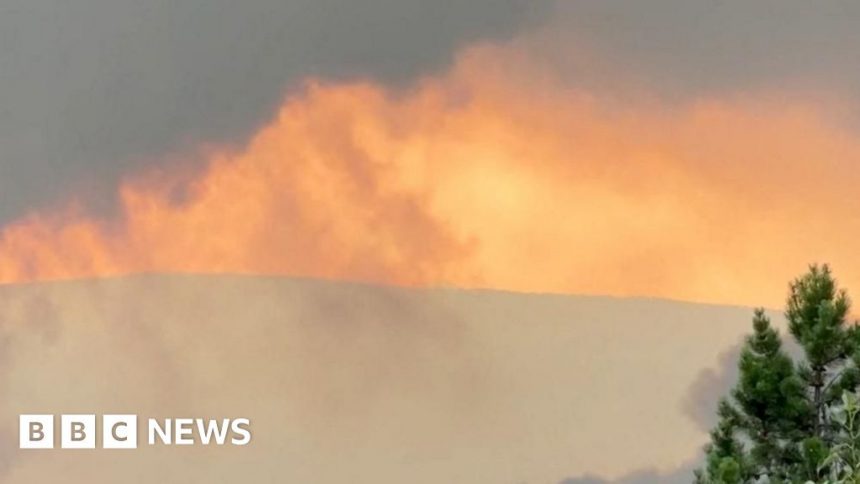‘Monster’ fires may have destroyed half of historic Canadian town
Huge, fast-moving wildfires have destroyed up to half of the historic Canadian town of Jasper, officials say, and the blazes are still out of control as firefighters try to save as many buildings as possible.
Entire streets of the main town in western Canada’s Jasper National Park have been levelled by the fire, with video showing smouldering rubble where homes once stood and the charred remains of cars.
While no deaths have been reported, some 20,000 tourists and 5,000 residents have fled the mountainous area in Alberta province, which has been hugely popular with tourists for decades.
During a news conference on Thursday, a tearful Alberta Premier Danielle Smith struggled at times to recount the scale of the damage, but said “potentially 30 to 50 percent” of buildings had been destroyed.
“There is no denying that this is the worst nightmare for any community,” she said, adding that Jasper National Park had been “a source of pride” for many generations.
Ms Smith became visibly emotional as she described the beauty of the park and its significance to the community, which relies largely on tourism. Some 2.5 million people visit the park, and nearby Banff National Park, each year.
Karyn Decore, the owner of the Maligne Lodge in Jasper, was on holiday when she learned her hotel had burned down. On Wednesday night, she received a photograph of the building in flames.
“I was horrified and devastated when I saw that photo,” she told the BBC. “I think it’s going to take a couple of days for the shock to wear down.”
“It’s really hard for everyone to comprehend that we lost one of our properties,” she said, adding that she intended to rebuild the lodge.
 Tourism Jasper
Tourism Jasper BBC journalist Wendy Hurrell was in Jasper National Park when the fires began to burn on Monday. She drove through the night with her husband and daughter in a rush to leave town.
“The storm was ferocious – the skies went dark red and there were whipping winds, fierce rain and lightning,” she said.
“We are some of the last travellers to see Jasper in its full beauty – it will be a very long time before it will recover. It’s utterly devastating for them all and my heart is breaking.”
Hundreds of firefighters from around the world have been deployed to help with the response, but officials warn the extent of the damage is still emerging. The focus on Thursday, they said, was on containing the towering flames which engulfed the town from two sides.
Pierre Martel, director for the national fire management programme at Parks Canada, said the fire was started by a lightning storm and escalated late on Wednesday as it was fanned by powerful winds.
“It [was] just a monster at that point,” Mr Martel said. “There are no tools we have in our tool box to deal with it.”
The flames reached 100m (328ft) high in some places, covering “an inordinate amount of space in a very little amount of time”, one official said.
 Jasper National Park
Jasper National Park Mike Ellis, Alberta’s minister for public safety, said the fire was 5km (three miles) outside of Jasper when it was pushed by the winds to the town in “less than 30 minutes”.
“Any firefighter will tell you there is little to nothing you can do when you have a wall of flames coming at you like that,” he said.
“Nobody anticipated that fire to come so fast, so large and so quickly.”
Justin Trudeau, Canada’s prime minister, thanked the emergency services for their response to the wildfires.
“As the heartbreaking images from Jasper emerge, I want to thank the brave first responders who are in Alberta right now, fighting to save every home and every community they can,” he said.
Environment Canada said there might soon be a reprieve from the hot and dry weather, which allowed the fire to grow, as rain is expected late on Thursday.
This marks another year of difficult fire conditions for the province. Last year, a record 2.2 million hectares burned in Alberta between 1 March and 31 October.
Outside Alberta, there are more than 45 active blazes in British Columbia and fires are burning in California, Oregon, Washington, Montana and Utah in the US.
The overall number of fires has decreased around the world over the last two decades.
But researchers say climate change could bring more lightning to forests in northern reaches of the globe, increasing the risk of wildfires.
With additional reporting from Eloise Alanna and Ottilie Mitchell






